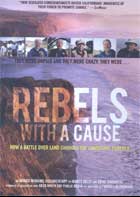
Rebels with a Cause: How a Battle over Land Changed the Landscape Forever 2014
Distributed by New Day Films, 190 Route 17M, P.O. Box 1084, Harriman, NY 10926; 888-367-9154 or 845-774-7051
Produced by Nancy Kelly and Kenji Yamamoto
Directed by Nancy Kelly and Kenji Yamamoto
DVD , color, b&w; 72 and 57 min. versions
General Adult
Ecology, Environmental Justice, Activism, Wetlands Preservation, Urban Parks
Date Entered: 05/01/2014
Reviewed by Andrew Jenks, California State University, Long BeachFor this reviewer, a resident of the Greater Los Angeles Area, perhaps the most shocking revelation about Northern California is the ease of access to breathtaking walks in forests and along seashores all along the coast. Even near the most densely populated areas of Silicon Valley and San Francisco, wetlands abound, accessible by paths to bikers and pedestrians. That some of the priciest real estate in the world could be saved from the seemingly inexorable force of development and speculation seems almost beyond comprehension, especially for a denizen of Southern California. This documentary details the decades-long struggles of grass-roots activists who fought against powerful development interests. Largely unknown, these figures are the subject of this film, and they constitute an important chapter in the history of the environmental movement. Thanks to them, as one subject of the film put it: “You don’t have to own a ranch in Northern California to enjoy walking in the wild.”
The urban wild spaces of Northern California were the byproduct of efforts by activists from the 1950s through the 1970s – precisely the time of California’s most intense urbanization and development. The movement to preserve some aspect of the wild world in rapidly growing urban spaces coincided with the effort to protect and expand wildness outside of human habitation and industry. Few, however, have paid much attention to those who have made urban life so much more tolerable than the strip-malled, asphalt-choked highways and avenues of most urban jungles inside and outside the state of California.
Some of the comments of the film subjects could have been qualified. The idea of an urban park was not nearly so novel for the 1950s as some activists claimed. Architects and urban planners since the 19th century had been arguing – albeit mostly unsuccessfully – for setting aside green spaces inside cities. New York’s Central Park is perhaps the most famous example, created by Frederick Law Olmsted and opened in 1858. So the movement to create open spaces had deeper historical roots than this documentary implies.
One lesson of this documentary is that saving open space from development requires money: to lobby the public and politicians and to buy out the private interests who often owned the land targeted as open space. The activists of Northern California had the spare time and resources to devote to their cause. Their wealth and relative privilege allowed them to resist the relentless privatization of space and property in the gung-ho period of California’s development. Their victory nonetheless established an important precedent: that not all space in capitalist America should be devoted to industry and real-estate development. To make such arguments in Cold War America was tantamount to proclaiming a love of communism. It also opposed the reigning policy of the US government up until the early 1960s: “Not a cent for scenery.” Yet the activists persevered, aided by high-level support from politicians, including JFK, who was influenced, among other things, by Rachel Carson’s 1962 Silent Spring. He approved the creation of the Pt. Reyes National Seashore Park in 1962.
Today, in a world where people must always work, and have little spare time for anything save family and vacation, preserving natural habitats in urban milieus remains a difficult proposition. That may be doubly true in a society like the United States where arguments for privatization and profit, and against public and governmental control, often dominate political culture. The denigration of community organizing and activism, whether in favor of the environment or other causes, strikes at the heart of the unique blend of grass-roots activism and political support which produced the open spaces of Northern California. It is therefore unclear from this documentary whether the activists in this film represent the beginning of a movement to naturalize the human-built world, and thus make it healthier and more livable, or merely a promising and inspiring experiment, a path only rarely taken.
Finally, for those who live in Marin County, the successful protection of land has had an ironic result: given the paucity of land on which to develop, prices for real estate in the remaining land for development have skyrocketed – reaching the point where only the super-rich can now afford to live in Marin County. One unintended consequence of the open space movement was therefore to reinforce class and social division in one of the most beautiful landscapes in the world.
Awards
- Audience Favorite, Mill Valley Film Festival